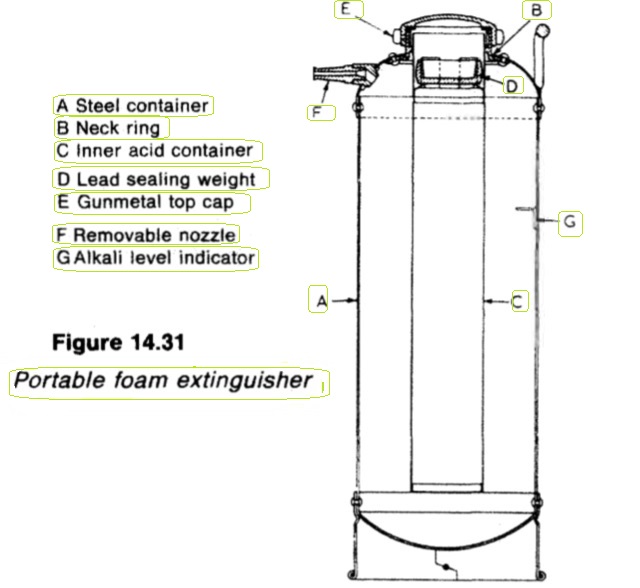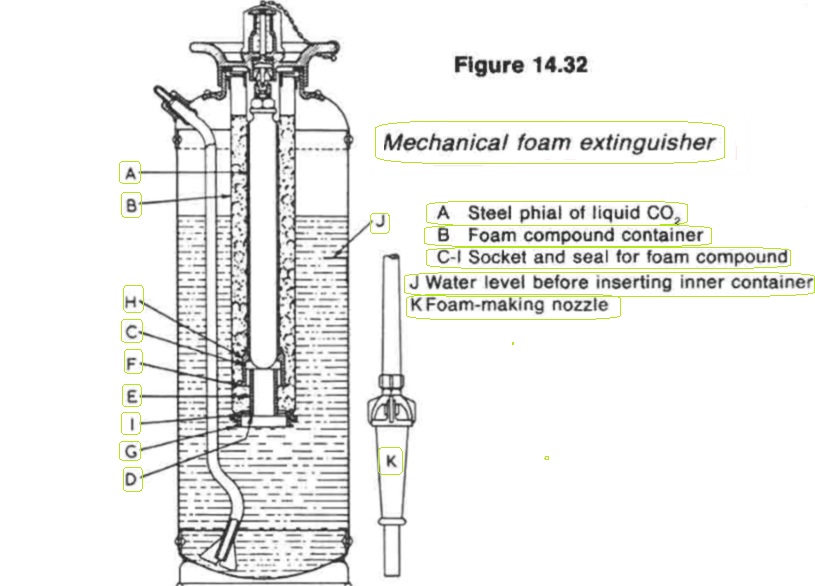
Home page||Fire protection||
Foam portable extinguishers -fire protection system for cargo ship
Fire protection on ships is provided by detection and fire-fighting equipment
together with structural features which are intended to contain an outbreak of
fire and the employment when required of non-combustible materials to
prevent its spread.
Chemical foam extinguisher
The outer casing of the portable (chemical) foam extinguisher (Figure 14.31) is similar in construction to the soda-acid appliance and is required to withstand the same initial test pressure of 25 bar and is retested at 21 bars every four years.
This extinguisher has a long inner container of polythene suspended from the neck ring and filled with aluminium sulphate solution. The outer container is filled to a marked level with sodium bicarbonate solution. A lead disc sits on top of the inner container and acts as a stopper. By inverting the extinguisher and shaking it, the disc is dislodged and the two solutions mix with the reaction:
Al2(SO4)3 + 6NaHCO3 = 2Al(OH)3 + 3Na2SO4 + 6CO2
The chemicals react in much the same way as those in the soda-acid extinguisher but the action is slower, giving time for bubbles to form. Foam-making substances added to the sodium carbonate determine the nature of the foam formed. The ratio of the foam produced to liquid is in the order of 8:1 to 12:1.
Because the extinguisher has to be inverted for operation, no internal pipe is fitted. When being recharged the cap seal should be examined and the pressure relief holes in the rim checked. The chemical foam extinguisher may be slow acting in cold conditions and unreliable if the chemical has deteriorated due to heat.

Figure : Portable foam extinguisher
Figure 14.31
A Steel container D Lead sealing weight F Removable nozzle B Neck ring E Gunmetal top cap G Alkali level indicator C Inner acid container
Mechanical foam extinguisher
The alternative type of portable (mechanical) foam extinguisher shown in Figure 14.32 is preferred to the chemical foam type, described previously. The appliance is filled with water and contains an inner container with a small metal bottle of liquid carbon dioxide, surrounded by a plastic bag of foam making compound.
To operate this extinguisher it is necessary to strike the plunger on the cap sharply, thus piercing the seal of the CO2 bottle. The gas then ruptures the plastic bag of foam compound and ejects the water and foam compound through a special nozzle which agitates the mixture and creates a mechanical foam. In this type of extinguisher the ratio of foam to liquid is about 8:1. The extinguisher has an internal pipe and is operated in the upright position.

Figure : Mechanical foam extinguisher
The first line of defence against fire in any area of the ship, is the portable fire extinguisher. Some common portable extinguishers that have been used at sea are described.
- Soda-acid extinguisher (discharges water)
The main body of the Soda acid extinguisher contains sodium bicarbonate, an alkaline solution. The extinguisher must be kept upright when in use. The operator strikes the pin at the top to break the acid phial so that acid and alkali mix, to form carbon dioxide which forces the water (with the chemical remains) out of the discharge. The device must be held upright in use. .....more
- Foam portable extinguisher
Mechanical Foam extinguisher is filled with water and contains an inner container with a small metal bottle of liquid carbon dioxide, surrounded by a plastic bag of foam making compound. .....more
- CO2 portable fire extinguisher
While carbon dioxide is used in some extinguishers as an inert propellant the gas is also used extensively as a blanketing agent. The carbon dioxide is in liquid form and is at a pressure of 6 bar at 20 deg C necessitating a strong container. This type of extinguisher can only be recharged ashore. .....more
- Dry powder portable extinguisher
This type of extinguisher contains sodium bicarbonate powder with a water proofing agent such as magnesium stearate to prevent caking. The container
shown holds a cartridge containing liquid carbon dioxide. On piercing its seal with the plunger pin, the gas is delivered through a tube to the bottom of the casing where it entrains the dry powder and carries it up through the discharge tube. .....more
Portable halon extinguisher
The use of halon in portable extinguishers should be discontinued when suitable alternatives are available because of the high ozone depletion potential.
Summarized below more fire protection equipments & guideline:
- Fire main system & related mechanism
The fire main
extends to the full length of the ship and from the machinery spaces to the
highest levels. Hydrants served by the main, are situated so that with suitable
hoses any area on the ship can be reached.
.....more
- CO2 fire extinguishing installation
Fire extinguishing installations employing CO2 stored under pressure at
ambient temperature are extensively used to protect ships' cargo compartments,
boiler rooms and machinery spaces. When released the CO2 is distributed
throughout the compartment, so diminishing the relative oxygen content and
rendering the atmosphere inert.
...... more
- Fire fighting equipments
Two independently powered pumps must be provided in all cargo ships of 1000 tons gross and over and in passenger ships of less than 4000 tons gross. Larger passenger vessels and passenger ferries must have three such pumps. The pumps are fitted with non-return valves if they are of the centrifugal type, to prevent loss of water back through open valves when not running.
..... more
- Details of fire detectors
A variety of devices are available for detecting fire in unmanned machinery
spaces but each has an ability to detect basically only one aspect. Thus, smoke
detectors based on the ionization chamber are able to recognize combustion
products but will not register radiation from a flame or heat.
.....more
- Machinery space fire & use of Walter Kidde CO2 system
Walter Kidde CO2 system employs pilot
CO2 cylinders to open the distribution system main stop valve and
subsequently the valves on the individual CO2 cylinders.
.....more
- Fire protection system for cargo holds
Holds for general cargo, have been protected against fire by fixed installations which deliver inert gas from an inert gas generator based on combustion of fuel (similar to the system available for inerting oil tankers) and halon systems.
.....more
- Low pressure CO2 storage
In some installations, the CO2 is stored in low pressure refrigerated tanks. The
cylindrical storage vessels are fabricated to the pressure vessel
requirements of the authorities. The tanks are of low temperature steel, fully
tested and stress relieved. They are mounted on supports designed to
withstand shock from collision.
..... more
- Halon system
Halon 1301 has the chemical formula CF3 Br being known as bromo-trifluoromethane.
It is a colourless, odourless gas with a density five times that of air and
extinguishes fire by breaking the combustion chain reaction.
.....more
- Multi-spray system for the machinery spaces
This system is similar to the sprinkler used in accommodation areas but the spray heads are not operated automatically. The section control valves (Figure 14.20) are opened by hand to supply water to the heads in one or more areas. Ready to use hoses can also be supplied. Fresh water is used for the initial charging and the system is brought to working pressure by means of the compressed air connection.
.....more
- Automatic sprinkler system
A network of
sprinkler heads is arranged throughout the spaces to be protected. Each sprinkler head is normally kept closed by a quartzoid bulb which is almost filled with a liquid having a high expansion ratio.
.....more
- Details various portable extinguishers & how to use ?
The first line of defence against fire in any area of the ship, is the portable fire extinguisher. Some common portable extinguishers that have been used at sea are described.
.....more
Home page||Cooling ||Machinery||Services ||Valves ||Pumps ||Auxiliary Power ||Propeller shaft ||Steering gears ||Ship stabilizers||Refrigeration||Air conditioning ||Deck machinery||Fire protection||Ship design
||Home ||
General Cargo Ship.com provide information on cargo ships various machinery systems -handling procedures, on board safety measures and some basic knowledge of cargo ships that might be useful for people working on board and those who working in the terminal. For any remarks please
Contact us
Copyright © 2010-2016 General Cargo Ship.com All rights reserved.
Terms and conditions of use
Read our privacy policy|| Home page||

